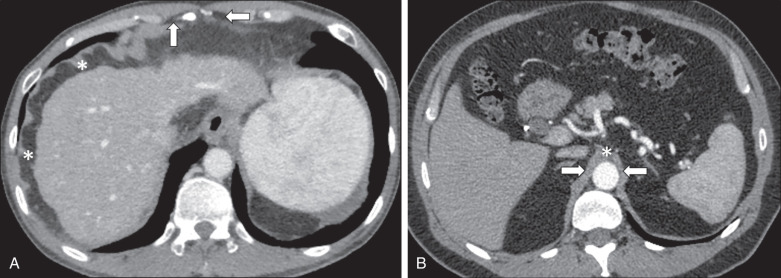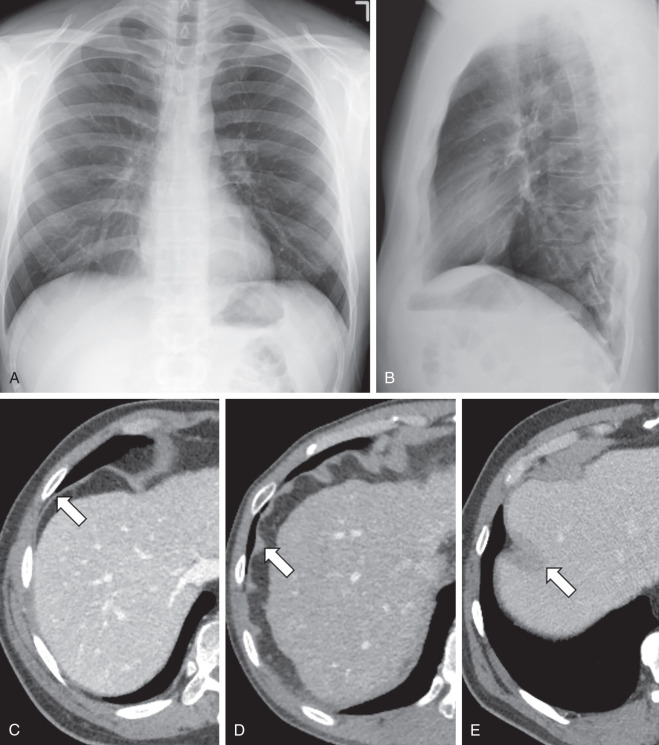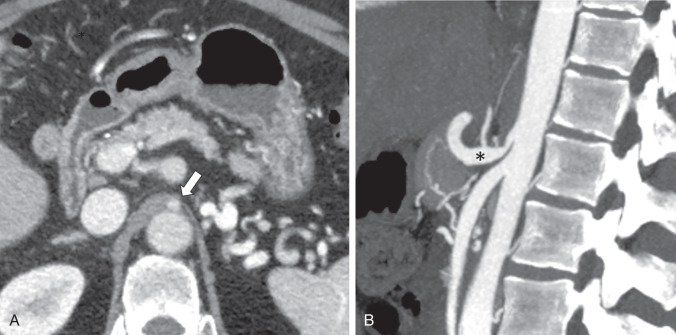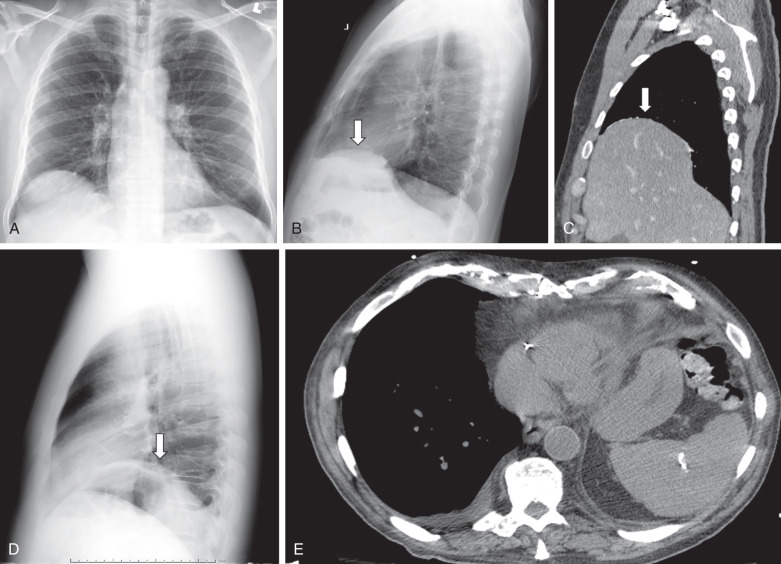Physical Address
304 North Cardinal St.
Dorchester Center, MA 02124
The diaphragm is a dome-shaped muscle with a central noncontractile tendon. Anteriorly and laterally, the diaphragm attaches to the body wall (ribs, costal cartilages, inferior sternum, and xiphoid process) via muscular diaphragmatic slips ( Fig. 33.1A ). Posteriorly, musculotendinous crura attach the diaphragm to the posterior body wall (lower thoracic and lumbar vertebrae). The right crus is typically larger and longer than the left. The right and left crura are joined by the median arcuate ligament, just anterior to the aorta (see Fig. 33.1B ).

The phrenic nerve is the motor and sensory nerve of the diaphragm. The phrenic nerves originate from C3, C4, and C5, traveling in the lateral compartment of the neck to the thoracic inlet. The right phrenic nerve descends laterally along the superior vena cava, right atrium, and inferior vena cava (IVC), branching to innervate the cranial surface of the diaphragm. The left phrenic nerve descends laterally along the aortic arch and left heart border before branching at the superior surface of the diaphragm. After branching, both phrenic nerves pass through the IVC hiatus and further innervate the inferior surface of the diaphragm.
There are three important openings related to the diaphragm—the vena caval hiatus, esophageal hiatus, and aortic hiatus. The vena caval hiatus is located within the midportion of the diaphragm, at the T8 vertebral level, allowing the IVC to pass from the abdomen to the thorax. Branches of the right phrenic nerve and lymphatics also pass through this hiatus. The esophageal hiatus is located within the muscle fibers of the right crus, at the T10 level, allowing for the passage of the esophagus, vagus nerve, and lymphatics. The aortic hiatus, despite its name, is not a true opening in the diaphragm. It is actually located posterior to the diaphragm, between the left and right crura, typically at the T12 level. This hiatus allows the aorta to pass posteriorly without being affected by muscular diaphragmatic contraction. The thoracic duct, and sometimes the azygous vein, also passes through the aortic hiatus.
The sternocostal triangles, or foramina of Morgagni, are small gaps on both sides of the medial anterior diaphragm, between the sternal and costal attachment points of the diaphragm, and are not openings within the diaphragm itself. The epigastric vessels and lymphatic channels pass through these foramina. Diaphragmatic hernias (i.e., Morgagni hernia) can occur at these sites.
The diaphragm is the primary muscle of respiration, innervated by the phrenic nerve. Central contraction increases craniocaudal thoracic volume and decreases thoracic pressure, resulting in the inspiration of air. Relaxation of the diaphragm allows for passive expiration secondary to elastic recoil of the lungs and pleura. Variable levels of muscle contraction induce forced air expiration and also aid in nonrespiratory functions, such as vomiting, defecation, and childbirth.
During inspiration, the three diaphragmatic hiatus change shape in different ways. The caval hiatus dilates, allowing increased blood flood through the IVC; the esophageal hiatus constricts, acting as a sphincter for the esophagus. Diaphragm contraction has no effect on the size and shape of the aortic hiatus.
Flattening of the diaphragm from increased lung volumes or emphysema will restrict the normal function of the diaphragm, limiting the degree of available excursion.
The diaphragm is well seen on plain radiography, fluoroscopy, ultrasonography (US), computed tomography (CT), and magnetic resonance imaging (MRI). Chest radiography is often the initial modality for the evaluation of diaphragmatic disease. Not only is it the initial modality of choice, but it is also the most common modality for detecting disease, with up to 90% sensitivity. The frontal chest radiograph provides excellent assessment of diaphragmatic position and contour. The lateral view confirms the contour of the diaphragm and provides additional information for the diagnosis of eventration—relative elevation of one diaphragmatic segment. Radiographs, however, are not specific enough to differentiate between most causes of nontraumatic and traumatic elevation.
Fluoroscopy (the so-called sniff test) provides real-time imaging of diaphragmatic motion. Typically, continuous fluoroscopic imaging is performed while the patient takes several normal tidal breaths, followed by several deep breaths. The patient is finally instructed to take short rapid sniffs through the nostrils, with real-time images obtained in both the frontal and lateral projections. Differing behaviors of the diaphragm during these maneuvers offer clues to the underlying disease, as discussed later.
US is a useful modality that also provides real-time imaging of the diaphragm, with the added benefits of portability (beneficial in the intensive care unit setting) and lack of ionizing radiation. Limitations of US include technologist's experience, small field of view, and artifacts due to overlying air within the lung or bowel. US can be used to evaluate diaphragmatic excursion and thickness, with breathing maneuvers similar to those for fluoroscopic evaluation. Low-frequency (1–3 MHz) probes, which offer greater depth, are used to evaluate motion and excursion, whereas high-frequency (7–18 MHz) probes offer improved spatial resolution, thus allowing accurate measurements of muscle thickness.
CT has a limited role in demonstrating diaphragmatic functional abnormalities. However, it is useful in identifying potential causes of dysfunction, such as malignancy. CT also readily identifies nondiaphragmatic causes of perceived elevation, such as pleural effusion, lung processes, and abdominal processes. CT with multiplanar reformats is critical for the assessment of the diaphragm in the trauma setting due to its high specificity for detecting rupture.
MRI is not commonly used for diaphragmatic assessment, mainly due to equipment availability, imaging time, low resolution, and radiologist inexperience. Dynamic MRI may have an increased role in the future due to its ability to perform real-time imaging without the need for ionizing radiation.
On frontal and lateral radiographs, the diaphragm should be smooth and dome-shaped, with the peak of the dome at least 1.5 cm above a line connecting the costophrenic angle and ipsilateral cardiophrenic angle. The right hemidiaphragm is usually higher than the left, typically between the sixth and seventh anterior ribs on an end-inspiratory frontal radiograph. The contours of the diaphragm should be sharp and visible through the heart as they contact the lower lobes of both lungs ( Fig. 33.2 ). Obscuration of this contour, known as the silhouette sign, suggests pathology in either lower lobe.

CT demonstrates similar findings as chest radiographs, with a sharp, smoothly marginated interface between the diaphragm and adjacent fat, lung, and abdominal organs. Scalloping is a commonly encountered normal variant, in which individual slips of muscle invaginate and indent the liver surface; this should not be confused with a hepatic mass (see Fig. 33.2 ). Scalloping is often accentuated on deep inspiration. The median arcuate ligament appears as a thin band of ligamentous tissue arching over the aorta. In certain cases, this ligament impinges on the celiac artery as it arises from the aorta, which may result in median arcuate ligament syndrome ( Fig. 33.3 ).

On real-time fluoroscopy or US, the diaphragm moves caudally during inspiration and cranially with expiration. Excursion of the diaphragm is most pronounced at the posterior periphery.
On US, the diaphragm appears as an echogenic band that normally thickens during inspiration. The thickening ratio can be calculated as follows:
Thickening <20% and/or end-expiration thickness <0.2 cm is suggestive of paralysis. Excursion can also be objectively measured between inspiration and expiration, with an excursion >2.5 cm considered normal. Excursion <2.5 cm and paradoxic motion of any degree are considered abnormal.
Evaluation of an elevated diaphragm should always be performed within the clinical context. In the asymptomatic patient, unilateral elevation is usually due to eventration. In a patient who has evidence of sternotomy, paralysis should be considered.
This is a focal weakness of an otherwise intact diaphragm resulting in a focal elevation. Eventration is caused by the replacement of normal muscular diaphragmatic tissue with fibrous tissue. The underlying cause may be congenital or acquired, with congenital muscular insufficiency being more common. In the adult, eventration is virtually always asymptomatic (discovered incidentally) and is generally unilateral. It usually affects the anteromedial portion of the diaphragm. Diagnosis can be confidently made on the lateral chest radiograph, which demonstrates relative elevation of the anterior portion ( Fig. 33.4A–C ). Real-time fluoroscopic or US imaging shows reduced excursion of the elevated segment, with normal movement of the remainder of the diaphragm. No follow-up imaging or treatment is needed in most cases.

In patients without imaging findings characteristic of eventration, possibilities include diaphragm paralysis or paresis, elevation due to mass effect or perceived elevation with normal position of the diaphragm. Radiograph can exclude lung volume loss. CT can be performed to rule out displacement due to mass effect from abdominal process. After exclusion of other causes, dynamic fluoroscopy or US can diagnose diaphragmatic paresis or paralysis.
This is commonly encountered after surgical interruption of the phrenic nerve. Less commonly, it is due to phrenic nerve invasion by neck and/or mediastinal malignancy, extrinsic nerve compression, neuropathy, or idiopathic causes. Paralysis is usually unilateral and asymptomatic but can be bilateral, in which case the clinical presentation may range from dyspnea to respiratory failure. Imaging demonstrates elevation of the entire diaphragm, as opposed to eventration, in which only a part of the diaphragm is elevated (see Fig. 33.4D and E ). On real-time fluoroscopy or US, the paralyzed diaphragm will exhibit reduced or absent caudal excursion during tidal and deep breathing. During a rapid sniff, characteristic paradoxic cranial motion of the affected diaphragm is observed, while the contralateral normal diaphragm descends. If both hemidiaphragms are affected, paradoxic motion may not be immediately recognized due to their symmetric movement. Any cranial movement of the diaphragm during a sniff should alert the radiologist to the presence of paralysis. On ultrasound, the paralyzed diaphragm is typically thinned, measuring <0.2 cm at end-expiration. Furthermore, real-time US can show a lack of normal thickening during breathing (<20% thickening between end-inspiration and end-expiration).
This indicates weakness of the diaphragm (not to be confused with paralysis). Similar to paralysis, the entire hemidiaphragm is elevated, with reduced or delayed excursion during tidal breathing, with paradoxic motion on rapid sniff. However, if some degree of caudal motion of the diaphragm is seen during deep inspiration, then a diagnosis of paresis is made rather than paralysis.
The diaphragm can be elevated without the presence of a structural or functional abnormality, such as with normal exhalation, increased abdominal pressure (e.g., with obesity, hepatosplenomegaly, ascites, Valsalva maneuver), or decreased lung volume (atelectasis or lung resection). Muscle weakness related to lupus myositis is also a well-known cause of diaphragmatic elevation.
Become a Clinical Tree membership for Full access and enjoy Unlimited articles
If you are a member. Log in here